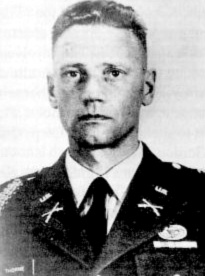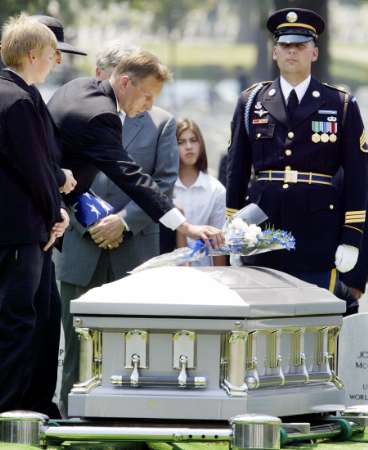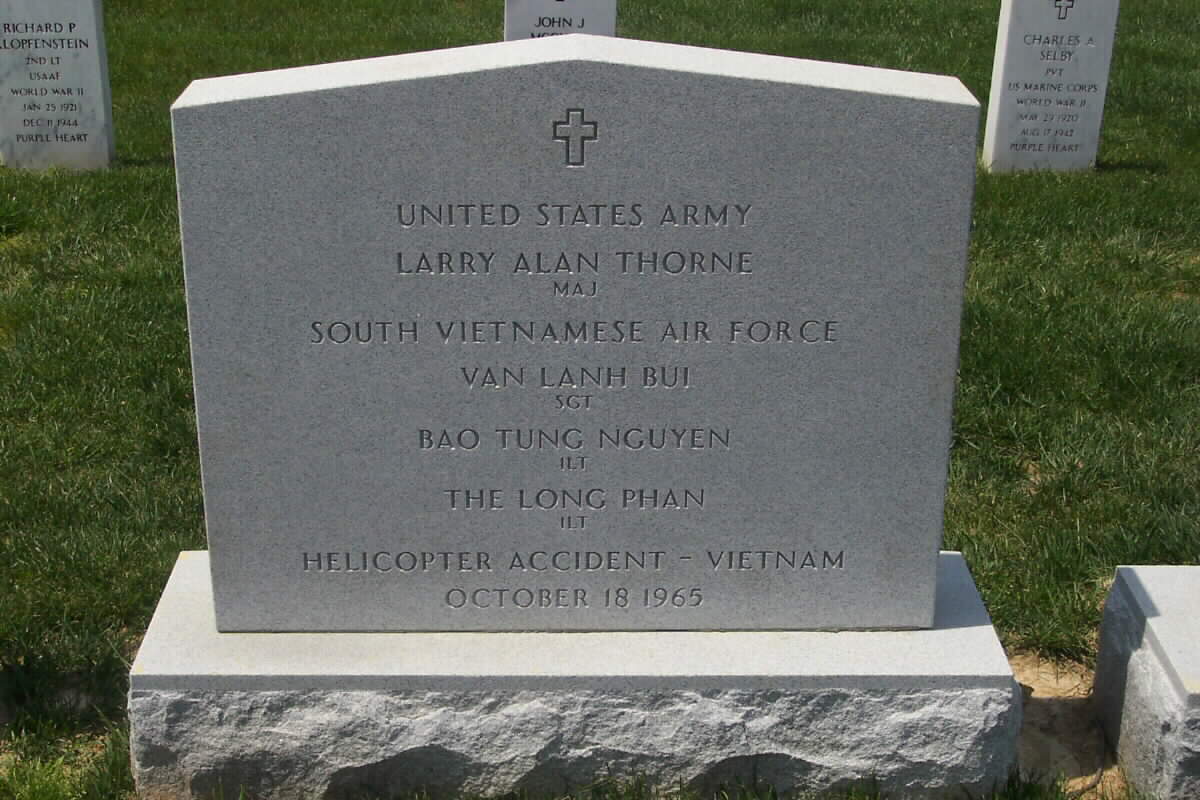Larry Alan Thorne was born on May 28, 1919 and joined the Armed Forces while in Norwalk, Connecticut.
He served in the United States Army, 5th Special Forces. In twelve years of service, he attained the rank of Major.
Larry Alan Thorne is listed as Missing in Action.
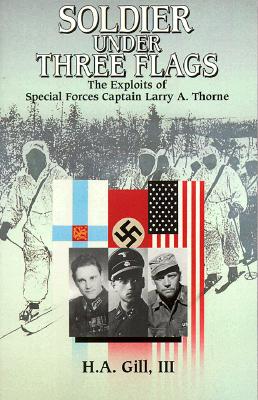
From various contemporary press reports:
Thorne was born in Finland in 1919, entered the Finnish army in 1938 and fought in the 1939-40 war against the Soviet Union. He subsequently conducted guerrilla warfare against the Soviet forces after the Finnish regime allied itself with Nazi Germany and reentered the war. As Shultz tells it, “In September 1944, Finland surrendered to the Soviet Union. Thorne didn’t. He joined the Germans, attended their school for guerrilla warfare, and then fought with their marines until the war ended.
“The Soviets wanted to get their hands on Thorne and forced the Finnish government to arrest him as a wartime German collaborator. They planned to take him to Moscow to be tried for war crimes. Thorne had other plans. He escaped, made his way to the United States, and with the help of Wild Bill Donovan became a citizen. The wartime head of the OSS knew of Thorne’s commando exploits…”
Thorne joined the U.S. Army and his expertise in guerrilla warfare led him into the Special Forces Group, where he was commissioned a first lieutenant, eventually rising to the rank of captain and commanding a Special Forces team in Vietnam, before joining SOG.
Name: Larry Alan Thorne
Rank/Branch: Major, United States Army
Unit: Headquarters Military Assistance Command, Vietnam Detachment SD 5891, 5th Special Forces Group, 1st Special Forces With orders to Studies and Observation Group Long Thanh, South Vietnam
Date of Birth: 28 May 1919 (Viipuri, Finland)
Home of Record: Norwalk, Connecticut
Date of Loss: 18 October 1965
Country of Loss: South Vietnam (official); Laos (actual)
Status in 1973: Killed/Body Not Recovered
Aircraft/Vehicle/Ground: CH34 “Seahorse”
Other Personnel In Incident: (none missing)
SYNOPSIS:
Larry Alan Thorne was born Lauri Allan Torni in Viipuri, Finland. As a young adult, he enlisted in the Finish Army where he obtained the rank of Captain. During the early years of World War II, he developed, trained and commanded the Finish ski troops. Under his strict and demanding leadership, the ski troops fought the Russians deep behind enemy lines for extended periods of time. During Finland’s wars against the former Soviet Union, he was awarded every medal for bravery that Finland could bestow including the Knight of the Mannerheim Cross, which is the equivalent of the American Congressional Medal of Honor. After Finland fell to the communists, Captain Torni joined the German SS in order to continue fighting the communists. After World War II, Lauri Torni made his way to the United States where he enlisted in the U.S. Army under the Lodge Bill. After completing basic training, Larry Thorne was selected for the budding Special Forces program. He quickly rose through the ranks, and with the assistance of allies within the military, received a commission. In 1964, Larry Thorne served his first 6-month tour of duty in South Vietnam.
In February 1965, then Captain Larry Thorne returned to Long Thanh, South Vietnam for his second tour of duty. While assigned to Headquarters, Military Assistance Command, Vietnam; Captain Thorne was instrumental in establishing the standard operating procedures employed by the fledgling Studies and Observation Group, better known by its acronym “MACV-SOG.” MACV-SOG was a joint service unconventional warfare task force engaged in highly classified operations throughout Southeast Asia. The 5th Special Forces Group channeled personnel into MACV-SOG (although it was not a Special Forces unit) through Special Operations Augmentation (SOA), which provided their “cover” while under secret orders to MACV-SOG. The teams performed deep penetration missions of strategic reconnaissance and interdiction that were called, depending on the location and time frame, “Shining Brass” “Daniel Boone,” “Salem House” or “Prairie Fire” missions.
When North Vietnam began to increase its military strength in South Vietnam, NVA and Viet Cong troops again intruded on neutral Laos for sanctuary, as the Viet Minh had done during the war with the French some years before. This border road was used by the Communists to transport weapons, supplies and troops from North Vietnam into South Vietnam, and was frequently no more than a path cut through the jungle covered mountains. US forces used all assets available to them to stop this flow of men and supplies from moving south into the war zone.
In September 1965, the infiltration of reconnaissance teams into Laos, Codenamed: “Shining Brass,” was approved, but severe limitations by Washington restricted the teams to penetrate no deeper than 50 kilometers into Laos. In case the team was captured the cover story derived for the first Shining Brass mission was that “they were looking for a crashed US Air Force C-123 cargo aircraft that was lost near the South Vietnamese/Lao border.” Further, in conjunction with planning cross-border missions, Larry Thorne flew as the observer for many intelligence gathering reconnaissance missions over eastern Laos. Because of this, he was very familiar with the entire area in which MACV-SOG’s teams would be operating.
One of the earliest helicopters employed in Southeast Asia, and the primary Marine Corps helicopter used during the early years of the war, was the Sikorsky UH34D Seahorse. This aircraft was already quite old when they arrived in the battle zone. However, both the US and South Vietnamese military found them to be extremely effective throughout the war. The Seahorse was frequently used to insert MACV-SOG teams into Laos.
On 18 October 1965, the first MACV-SOG cross-border mission was to be inserted by South Vietnamese Air Force helicopters into a target area approximately 20 miles northwest of Kham Duc known as “D-1” to locate and report on North Vietnamese activity operating on and near Highway 165. All personnel were initially transported to Kham Doc Forward Operating Base (FOB) in preparation for their launch into Laos in search of what would eventually be known as the “Ho Chi Minh Trail.” Master Sergeant Charles “Slats” Petry, team leader; Sergeant First Class Willie Card, 1 South Vietnamese Army Lieutenant and 7 Nungs comprised Recon Team (RT) Iowa, the team to be inserted.
As the men of RT Iowa prepared their weapons and gear, Major Norton and Captain Thorne brought the SVAF Kingbee, US Army Huey and USAF Forward Air Controller (FAC) aircrews together in the operations shack to plan the team’s insertion at dusk. RT Iowa’s landing zone (LZ) would be a slash-and-burn area that resembled an old logging clear-cut from the Pacific Northwest. U.S. Air Force Major Harley B. Pyles, pilot; and U.S. Marine Corps Captain Winfield W. Sisson, observer and Marine MACV-SOG air liaison officer; comprised the crew of an O1E Bird Dog, call sign “Bird Dog 55,” the number 2 aircraft in a flight of two that would coordinate all aircraft involved in inserting RT Iowa. Major Harold Nipper flew the lead Bird Dog. In addition to the FACs, the U.S. Air Force provided a flight of B-57s to conduct a Combat Air Patrol (CAP) for this mission should the ground team run into trouble and greater firepower was needed.
At 1745 hours, both FACs departed Kham Duc. Minutes later Major Pyles transmitted the weather conditions were marginal, with clouds below the mountaintops and increasing ground fog. In spite of the existing conditions, the FAC pilot believed the low flying helicopters could weave around the worst of it and called for the rest of the mission’s aircraft to launch. At 1800 hours, the Kingbee helicopters lifted off with Cowboy, piloting the lead SVAF Kingbee; and Mustachio piloting the #2 Kingbee. The third Kingbee was a chase aircraft that would retrieve the crew and passengers of any aircraft that went down. Captain Thorne, who was not about to remain at Kham Duc, was the only passenger aboard the chase aircraft. US Army Huey gunships launched at the same time to provide air cover should it be needed at any time during the mission.
As the Kingbees and Huey gunships flew low over the countryside, all they could see were rolling hills, wild rivers and waterfalls. The weather proved especially hazardous, forcing them to weaving between thunderheads and sunbeams while avoiding sporadic .50 caliber machinegun fire, all of which missed. The flight arrived over the target area just before sundown. The all aircraft circled the area looking for a way to get down to the clearing through the thick angry clouds that blanketed the area. Minutes before Captain Thorne intended to cancel the mission and return to Kham Duc, the clouds opened up slightly allowing the two Kingbees carrying RT Iowa to spiral into the slash-and-burn clearing, rapidly discharge their passengers and immediately climb for altitude. As Larry Thorne’s helicopter and Major Pyles’ Bird Dog attempted to descend, the clouds again closed up. Captain Thorne ordered the now empty Kingbees to return to Kham Duc. Shortly thereafter, Captain Thorne also released Bird Dog 55 and the Huey gunships to return to base.
As the weather worsened, Larry Thorne continued to orbit D-1 near the landing zone in case RT Iowa ran into trouble. As Cowboy and Mustachio flew toward the east, they reported low-level visibility so bad that they had to climb to 8,500 feet in order to clear the top of the clouds. Once Captain Thorne received a message from RT Iowa that their insertion was successful, he transmitted that his aircraft was also on its way back. At 1810 hours, Major Nipper released the B-57s and began his own return flight to Kham Duc. Approximately 5 minutes after receiving the patrol’s report, the other aircrews heard a constant keying of a radio for roughly 30 seconds. After that, only silence was heard in response to repeated attempts to raise anyone aboard the Kingbee.
Intense search efforts were initiated at first light the next morning and continued for the next month, but found not trace of the missing Kingbee, its crew and passenger. Shortly after loss, Larry Thorne was reported as Missing in Action. Prior to his final mission, Larry Thorne had been recommended for promotion to Major and was being groomed for a staff position as an intelligence officer. His posthumous promotion to Major was approved in December 1965.
Early on 19 October 1966, the U.S. Army declared that Captain Larry A. Thorne was no longer being listed as Missing in Action, but had been declared Presumed Killed in Action in South Vietnam, not Laos. The Department of the Army officially stated, “On 18 October 1965, Major Thorne was a passenger aboard a Vietnamese Air Force CH34 helicopter which crashed about 25 miles south of DaNang.” Prior to the end of the war, the wreckage of the Kingbee was found and a search and rescue-recovery (SAR) team inserted into the crash site. According to reports, the SAR personnel found and recovered the remains of the South Vietnamese aircrew, but found no sign of Larry Thorne either dead or alive.
The number of MACV-SOG missions conducted with Special Forces reconnaissance teams into Laos and Cambodia was 452 in 1969. It was the most sustained campaign of raiding, sabotage and intelligence gathering waged on foreign soil in US military history. These teams earned a global reputation as one of the most combat effective deep-penetration forces ever raised.
If Larry Thorne died in the loss of the Kingbee, he has a right to have his remains returned to his family, friends and country. However, if he survived, he most certainly could have been captured by NVA forces openly operating throughout the region and his fate, like that of other Americans who remain unaccounted for in Southeast Asia, could be quite different.
Since the end of the Vietnam War well over 21,000 reports of American prisoners, missing and otherwise unaccounted for have been received by our government. Many of these reports document LIVE America Prisoners of War remaining captive throughout Southeast Asia TODAY.
American military men in Vietnam and Laos were called upon to fly and fight in many dangerous circumstances, and they were prepared to be wounded, killed or captured. It probably never occurred to them that they could be abandoned by the country they so proudly served.
Larry A. Thorne is the only American POW/MIA to fight communism under three flags – those of Finland, Germany and America.
THORNE, LARRY ALAN
- Remains Found 1999 – Identified 2003, Buried Arlington June 26, 2003
- Name: Larry Alan Thorne
- Rank/Branch: O3/US Army
- Unit: HQ MACV SD5891
- Date of Birth: 28 May 1919
- (Viipuru, Finland – military records – correct spelling is Viipuri)
- Home City of Record: Norwalk Connecticut
- Loss Date: 18 October 1965
- Country of Loss: South Vietnam
- Loss Coordinates: 152558N 1074744E (YC895105)
- Status (in 1973): Killed/Body Not Recovered
- Category: 3
- Acft/Vehicle/Ground: CH34
REMARKS:
Source: Compiled in 1989 from one or more of the following: raw data from U.S. Government agency sources, correspondence with POW/MIA families, published sources, interviews. Updated by the P.O.W. NETWORK 2003.
SYNOPSIS:
Larry Alan Thorne was born Lauri Allan Torni on May 28, 1919. As an adult in Finland, he joined the Finnish army where he attained the rank of Captain. His valor earned him the equivalent of the Congressional Medal of Honor, the Mannerheim Medal. He was so successful as a ski troop commander that the unit patch carried his initial “T” with a lightning bolt through it. At the end of the Winter War, Torni joined the German “SS” to fight the Russians. When the Continuation War began, he returned to Finland and again commanded his ski troops.
Following Finland’s second defeat to the Russians, Torni was imprisoned by the communists as a war criminal. He escaped prison three times and made his way to the United States where he enlisted in the U.S. Army as a private.
Throughout the late 1950’s, the budding U.S. Army Special Forces had been building a controversial force to conduct unconventional warefare. These unconventional warfare warriors had to be able to master critical military skills needed to train and lead guerrilla warriors, to be inserted anywhere in the world by any means of transportaion, to survive the most hostile environment, and to take care of themselves and others under the pressures of harsh combat conditions and isolation. At the same time, these individuals had to be independent thinkers, able to grasp opportunities and innovate with the materials at hand. In order to control and lead irregular fighters, they had to understand people, languages, and foreign cultures. Most important, the Special Forces warriors had to posses the intelligence, knowledge, tact, and acumen to successfully transform ordinary civilians into an effective military threat to a strong and cunning occupation army.
In addition to recruiting rugged individuals possessing these attributes from regular army formations, the Special Forces attracted a proven lot of hardy, versatile volunteers from Finland and other European countries through the Lodge Act, Public Law 957 of the 81st Congress, sponsored by Henry Cabot Lodge, Jr. Regardless of his background, each SF volunteer underwent strenuous physical conditioning, including paratrooper training, and was extensively tested to determine his best skills and abilities. He then received comprehensive instruction in his specialty area.
Thorne was selected for the Special Forces and ultimately led an important mountain rescue mission to a crashed USAF plane in the middle east. The plane was carrying classified equipment and three earlier attempts to reach it had failed. Next, he went to Vietnam, he and his 7th Special Forces A-734 established the camp at Tinh Bien in April 1964 near the Delta’s Seven Mountains area, which bushwacked so many Viet Cong that it becamse a serious thorn to the VC lifeline into Cambodia. In a second tour of Vietnam, attached to Headquarters Company, MACV, Special Detachment 5891, the Vietnamese Air Force CH34 helicopter on which Thorne was a passenger crashed about 25 miles southwest of Da Nang. When rescue workers went to the site, they recovered the remains of the Vietnamese crew, but found no sign of Larry Thorne. He had simply disappeared. Thorne’s photo is maintained in a pre-capture photo group shown to defectors for POW/MIA identifications purposes, yet Thorne was classified killed in action the day after the crash. His remains were never found. Men who served with him believe that Larry is still alive. They gather to toast his health every year. No one, they say, is better equipped to survive than Larry Thorne.
In Finland, Lauri Torni is a national hero. In the United Sates, Larry Thorne is forgotten by all but a few. His family believes he is still alive, even considering he was 70 years old this year (1989). Lauri Torni hated the threat of communism so much that he was willing to join any army to fight it. We must never forget men like Thorne. It is to them that we owe our freedom. We also owe them theirs.
UPDATE 1998
In June of 1998, the book THE SOLDIER UNDER THREE FLAGS was made available by Pathfinder publishing. The author, H.A. Gill, III is a graduate of the
Citadel. He served as an infantry offcier in the U.S. Army and currently
works for an aerospace corporation. The book about Larry Thorne has 208 pages and 37 photographs, and is available for 14.95.
ISBN : 0-934793-65-4
Pathfinder Publishing
1-800-977-2282
458 Dorothy Avenue
Ventura, CA 93003
Subject: Re: Major Larry A. Thorne – Deceased – 18 Oct.’65
In a message dated 6/6/03 4:02:23 PM Central Daylight Time,
sincere@patriot.net writes:
Gentlemen: Great News. FINALLY after 37+ years – CLOSURE. The USG has finally closed the case on Larry A. Thorne. Needless to say – it has been a long struggle for the past few years. Larry will be interred at Arlington National Cemetery on 26 June 2003, reportedly scheduled for 0900 hours commencing at the ANC Administration Building. Tentatively plans for a memorial service are also scheduled for the evening of 25 June. Time and Location as yet to be determined.
As many of you are aware Larry was lost in the clouds on 18 October 1965 on a CH-34 “KINGBEE” helicopter from the 219th Vietnamese Air Force Squadron while performing a C&C mission out of Kham Duc for the very first OP-35 cross-border reconnaissance mission (RT Iowa) being conducted by Charles “Slats” Petry, Willie Card and four “little people” and never seen again.
“Slats” and his RT were able to infiltrate the AO via another “KINGBEE,” but, almost immediately following insertion the weather turned to shit. John Voter was in another “KINGBEE”, acting as “Chase.” Due to the same miserable bad weather in the area that Larry got caught up in, John was forced to land at an emergency site and fortunately was able to return to Kham Duc the next day. “Slats” and his RT conducted a successful mission and returned to Kham Duc at a later date.
In 1999 a US/VN JTF/FA conducted an excavation of a CH-34 KINGBEE crash site and recovered several fragments of bones, miscellaneous equipment and a Swedish “K” SMG. Based on that limited evidence coupled with a series of forensic and DNA tests, it has taken the USG till now to arrive at a conclusive decision that this was in fact Larry’s ill-fated aircraft.
Juha Rajala, Larry’s nephew has scheduled a Press Release for 10 June in Finland announcing the decision by the USG as it relates to Larry. However, a close family friend, Ilkka Nieminen has secured permission from Juha for an early release of this information in order to permit Larry’s American friends sufficient time to coordinate travel and accommodation arrangements in the event they desire to attend the Memorial Service (25 June) and Interment (26 June 2003) at Arlington National Cemetery. A number of Finnish dignitaries including Juha (representing the Thorne family) will be in attendance at both services. If anyone plans on attending – request you advise me and I will be pleased to pass it on to the family. I will also secure a name and address in Finland for anyone desiring to dispatch a card to Juha and/or Salme, the last surviving sister of Larry.
That is it for now. Does anyone know how to get in touch with John Voter? Advise. Regards, Clyde (Clyde J. Sincere, Jr. 11722 Lariat Lane Oakton, Virginia 22124-2323 (703) 620-0953 sincere@patriot.net
Legendary Finnish war hero Lauri T”rni (Larry Thorne) to get final resting place in Arlington National Cemetery Remains of victims of 1965 helicopter crash will be interred simultaneously.
The last picture of Larry Thorne was taken three days before he disappeared. The Finnish-American war hero is on the left in the picture with some American and South Vietnamese brothers in arms.
Foreign – Tuesday 17 June 2003
By Asko Temmes
Lauri T”rni (1919-1965) was a World War II hero and a recipient of the Mannerheim Cross – the highest award for gallantry on the field – in his native Finland. After the end of hostilities, the fiercely anti-Communist T”rni found life at home difficult, and he emigrated to the United States. There he entered the U.S. military and became a decorated and much-revered Vietnam War hero in Special Forces. T”rni, by now better known to his colleagues as Larry Thorne, disappeared after the helicopter he was in went down close to the Laos border in 1965. At long last, his remains have been formally identified, and he will be laid to rest in the Arlington National Cemetery on June 26 of this year. T”rni’s remains will be buried in the same coffin with those of three other victims of the same helicopter crash.
When the crash site was finally located four years ago, the U.S. military made inquiries concerning T”rni’s final resting place. In Finland, hopes were raised for the national hero’s possible burial in his home country. Separating the remains of the crash victims, however, turned out to be an impossible task, which led to a pragmatic decision to organise a joint burial at Arlington. “A traditional American military officer’s burial is to be expected, with trumpets and salutes”, says T”rni’s nephew Juha Rajala, who is also the Vice President of the Lauri T”rni Tradition Guild in Finland. The Tradition Guild will send representatives to the funeral, and the Finnish Defence Forces will decide on their participation next week. It is likely that the representation from the U.S. Army will be at the level of a General. T”rni still enjoys an awesome reputation amongst military men even today, nearly 40 years after his demise. The Arlington National Cemetery is in Virginia, across the Potomac River from the nation’s capital, Washington DC. Arlington Cemetery contains about 270,000 graves, most of them belonging to individuals who served in the U.S. armed forces. Arlington’s most famous grave, accompanied by an eternal flame, is that of President John F. Kennedy. The day before the interment, a memorial service will be arranged. Larry A. Thorne, the name by which T”rni is remembered in the United States, was a captain and a Green Beret in the U.S. Special Forces. Special Forces will also organise a tribute to their hero. After T”rni’s status was changed from “missing in action” to “presumably killed in action”, a memorial service was already organised in Helsinki back in 1967.
Excavation at the crash site in Vietnam was launched four years ago. The helicopter crashed on a mountain-top in a severe thuderstorm. Three South Vietnamese soldiers had accompanied T”rni on the ill-fated helicopter flight, returning from a secret mission, probably in Laos. Two of the South Vietnamese lieutenants were identified from DNA samples. The third soldier, a machine-gunner, was recognised from his identification tag. T”rni’s fate was finally confirmed, not by a DNA sample, but from his dental records. T”rni had a dental crown on his tooth number 18.
Even before the medical confirmation, two pieces of evidence pointed strongly to the final outcome: the serial number found on the helicopter’s rotor blade and the Swedish-made machine pistol that T”rni had taken with him, which was found nearby. The Lauri T”rni Tradition Guild has planned a trip to Vietnam, to the site of their hero’s death. Thirty of the Finnish Army infantrymen who accompanied T”rni on numerous dangerous missions in World War II are still alive, among them Finland’s former President Mauno Koivisto. Next year Lauri T”rni would have celebrated his 85th birthday.
More on this subject:
Legendary Finnish war hero Lauri T”rni (Larry Thorne) to get final resting place in Arlington National Cemetery.
BACKGROUND: War hero’s unbelievable life in the service of two countries
Previously in HS International Edition:
DNA testing to resolve the fate of Larry Thorne (14.9.1999) T”rni was not the only Finnish soldier to serve under more than one flag, as this article indicates: Finnish officer becomes legend in US Army (3.10.2000)
One Burial, Four Fighters
There’s a story behind almost every funeral at Arlington National Cemetery, but a group burial at the cemetery earlier this summer was particularly uncommon.
A single casket bearing the remains of four men killed in a helicopter crash during the Vietnam War was buried June 26 with military honors. Three of those laid to rest were South Vietnamese Air Force crew members. The fourth was a Finnish war hero from World War II who later became a legendary U.S. Special Forces officer, portrayed on film by John Wayne.
The story begins with the Winter War, which began with the Soviet invasion of Finland in 1939, when Lauri Torni fought against attacking Red Army troops. During World War II, Torni trained with the Waffen SS in Germany and fought alongside Finnish and German guerrillas against the Soviets. He was a recipient of the Mannerheim Cross, Finland’s highest award for gallantry in the field.
Torni found life in Finland difficult after the war and moved to the United States, enlisting in the U.S. Army in 1954 and later gaining citizenship. With the new name of Larry Thorne, he became an officer in the Green Berets, of the Army’s elite Special Forces, serving in operations in Iran and Vietnam, according to an article last year in Military Review, an Army publication.
On his second tour in Vietnam in 1965, assigned to the 5th Special Forces Group, Thorne was involved in the secret war in Laos. On October 18, 1965, he was on a covert mission into Laos, riding in a South Vietnamese Air Force H-34 helicopter. In thick clouds near the Laotian border, the helicopter crashed into a mountaintop. Also on board were three South Vietnamese crew members: Lieutenant Bao Tung Nguyen, First Lieutenant The Long Phan and Sergeant Vam Lanh Bui.
Searches of the rugged terrain found nothing. Thorne was declared killed in action by the Army in 1966. In America, posthumous fame arrived when he was portrayed by Wayne in the 1968 film “The Green Berets.”
A joint U.S.-Socialist Republic of Vietnam team found the wreckage in 1997, and the site was excavated in 1999. The remains were subsequently identified by the U.S. Army Central Identification Laboratory in Hawaii.
The three Vietnamese service members were eligible for burial at Arlington because their remains were commingled with those of an American serviceman, according to a spokeswoman for Arlington Cemetery.
Now the three lie together with Thorne in America’s most hallowed ground, a unique ending to a unique story.
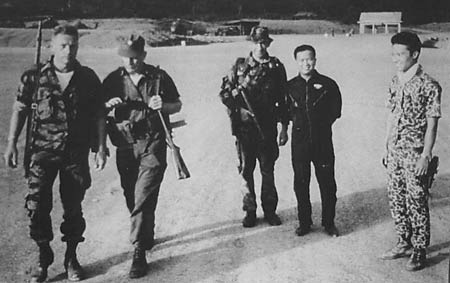
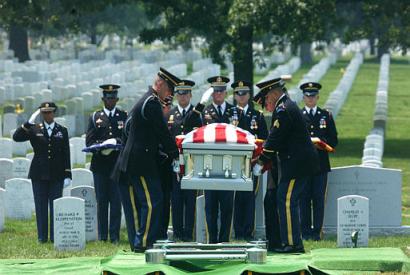
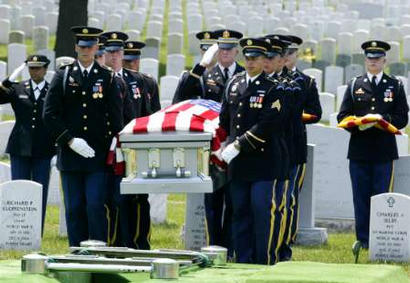
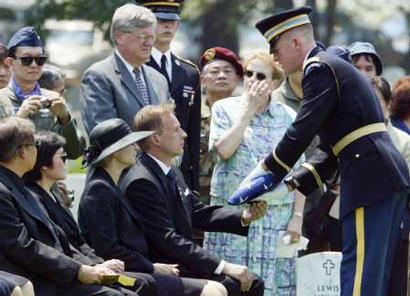
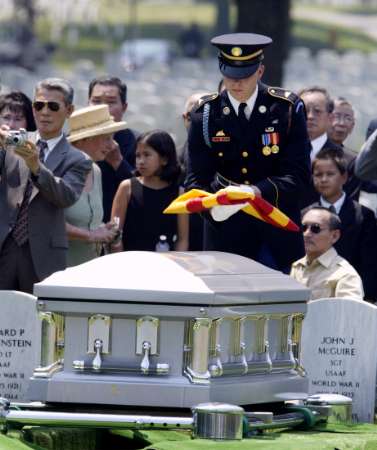
THORNE, LARRY ALAN
- MAJ US ARMY
- VETERAN SERVICE DATES: 10/18/1955 – 10/18/1965
- DATE OF BIRTH: 05/28/1919
- DATE OF DEATH: 10/18/1965
- DATE OF INTERMENT: 06/26/2003
- BURIED AT: SECTION 60 SITE 8136 – Arlington National Cemetery
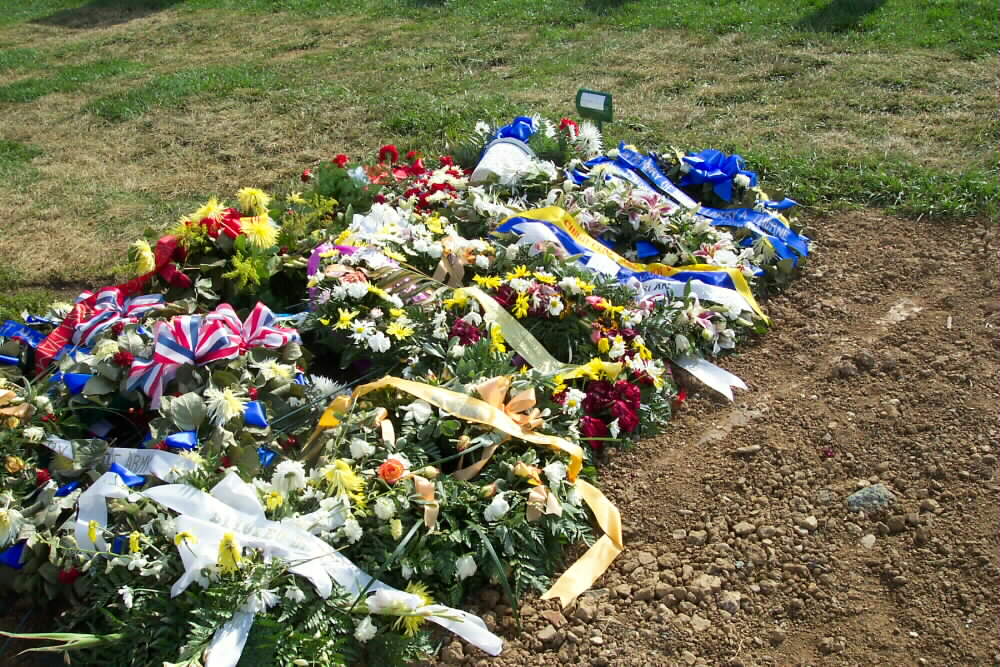
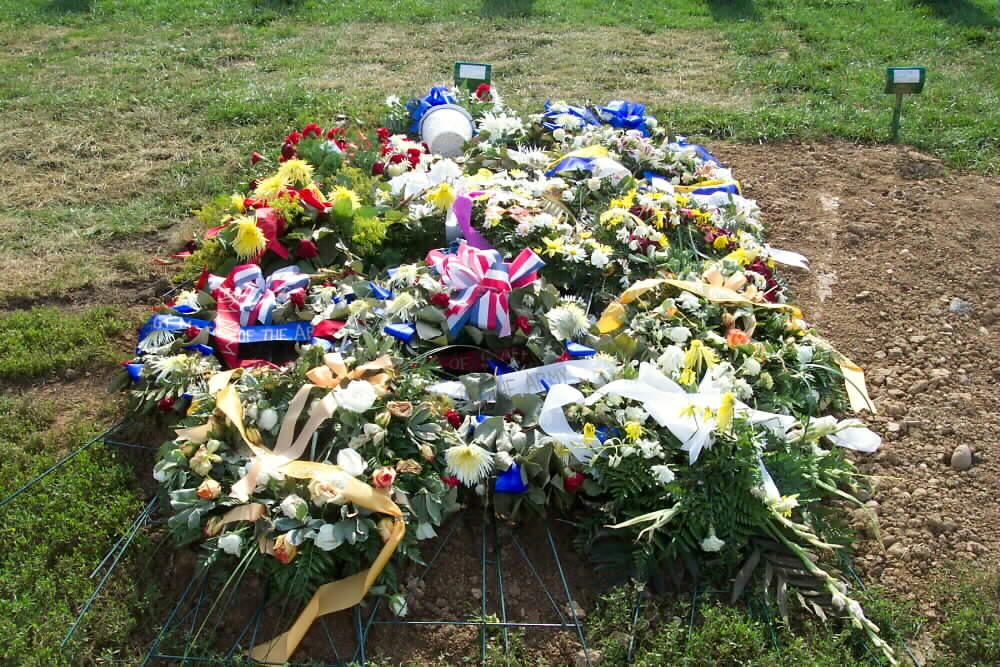
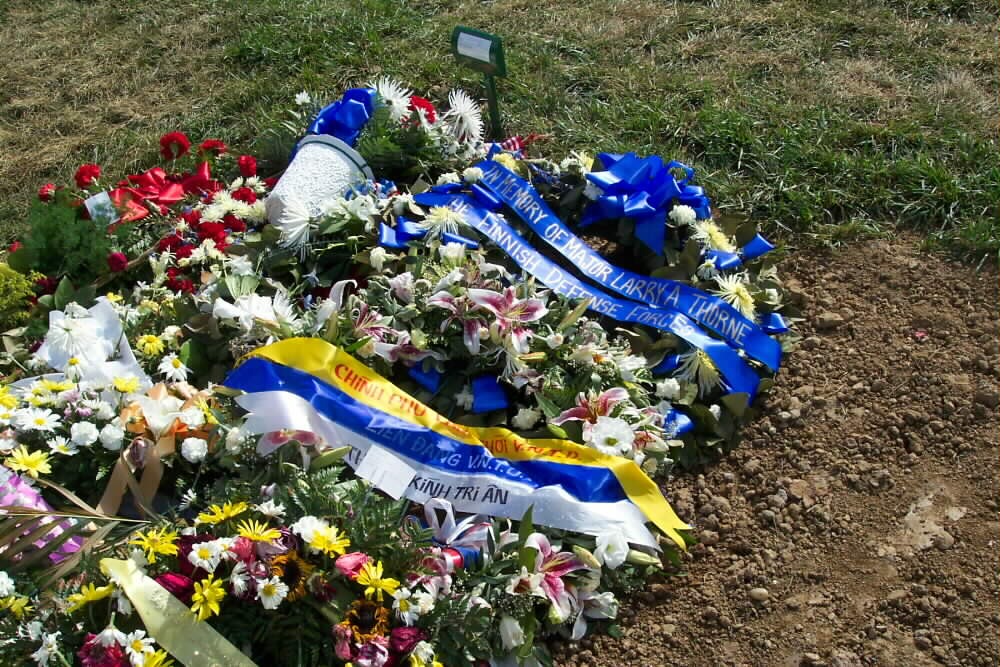
Michael Robert Patterson was born in Arlington and is the son of a former officer of the US Army. So it was no wonder that sooner or later his interests drew him to American history and especially to American military history. Many of his articles can be found on renowned portals like the New York Times, Washingtonpost or Wikipedia.
Reviewed by: Michael Howard

